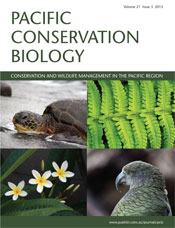
Pacific Conservation Biology
Volume 21 Number 3 2015
PC15026Integrating rehabilitation, restoration and conservation for a sustainable jarrah forest future during climate disruption
Unsustainable forest exploitation coupled with a shift to a dryer, warmer climate has changed the northern jarrah forest, with ecologically disruptive consequences. Achieving sustainability now requires reassessment of existing bauxite rehabilitation, with future rehabilitation focussed on the understorey. This should be accompanied by valorisation and restoration of the surrounding forest matrix. Escalating challenges under projected transformative change will increasingly require societal engagement.
PC14923Natural history and conservation biology of the tooth-billed pigeon (Didunculus strigirostris): a review
With its large hooked beak suggesting a link to the dodo, Samoa’s tooth-billed pigeon now faces the same fate. Major cyclones and human clearance have left the species with little pristine forest. Hunting, rats and cats compound the problem. Major investment in research and management is urgently needed.
PC14918What factors affect the density of cane toads (Rhinella marina) in the Solomon Islands?
Cane toads (Rhinella marina) were first introduced to the Solomon Islands in the 1940s. Surveys were conducted between May 2009 and August 2012, and toads were recorded on 11 of 13 islands. Modified Akaike’s Information Criterion (AICc) tests were used to establish the most parsimonious model for cane toad density in Solomon Islands.
PC14919Using high-definition aerial photography to search in 3D for malleefowl mounds is a cost-effective alternative to ground searches
3D high-definition aerial photography was demonstrated to be more accurate and cost-effective than on-ground searches for active malleefowl (Leipoa ocellata) mounds for environmental impact assessments in the mid-west of Western Australia.
PC14920Local and expert knowledge improve conservation assessment of rare and iconic Fijian tree species
In developing countries, little published information is available for many species. Using visits to populations and existing local knowledge, we evaluated the conservation status of four rare, iconic Fijian trees. This approach produced important new information about the performance and size of populations, highlighting its potential to increase our knowledge about threatened Pacific Island species.
PC14922Fauna-rescue programs can successfully relocate vertebrate fauna prior to and during vegetation-clearing programs
Fauna-rescue programs undertaken before and during vegetation clearing for mining and land development projects can significantly reduce the number of vertebrates that are lost and injured during this process. Different machine types and techniques can significantly alter the survival rate during vegetation clearing programs.
PC14921Termitaria are an important refuge for reptiles in the Pilbara of Western Australia
Deconstructed termitaria (n = 158) near Onslow in the Pilbara of Western Australia supported an average of 30.4 vertebrates and 4.5 species. The fauna assemblage in termitaria was significantly different to that in adjacent areas, with the Pilbara dtella (66.3% of all captures) being the most abundant species present.
PC15017Habitat associations of a rare South Australian sea star (Parvulastra parvivipara) and a co-occurring chiton (Ischnochiton variegatus): implications for conservation
The sea star Parvulastra parvivipara occurs only on western Eyre Peninsula, South Australia. Its habitat requirements include small unstable boulders, suggesting a susceptibly to any increases in physical disturbance. Large individuals of a co-occurring chiton were associated with small, heavily-encrusted boulders. Information of such habitat requirements is necessary for conservation planning for this coastline.
PC14924When losing your nuts increases your reproductive success: sandalwood (Santalum spicatum) nut caching by the woylie (Bettongia penicillata)
The role of the critically endangered woylie marsupial in recruiting sandalwood in south-western Australia was investigated in a eucalypt woodland. Woylies preferentially carried and buried sandalwood, then quandong seed, before investigating legume seed. The study highlights the importance of providing seed to seed-dispersal marsupials for ecosystem repair.



